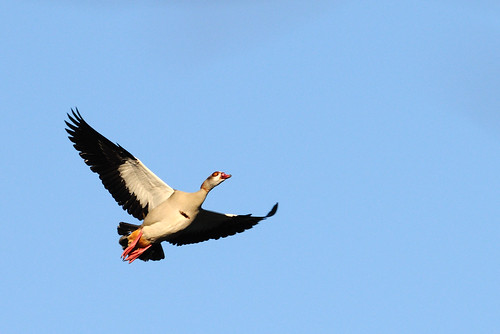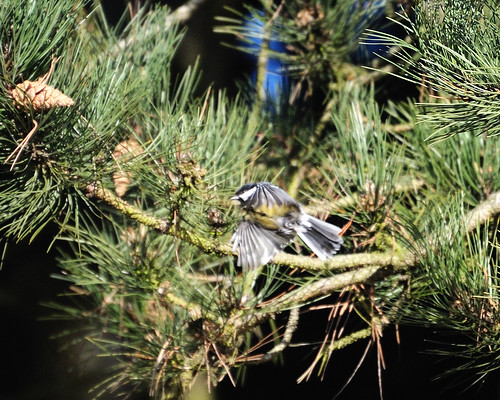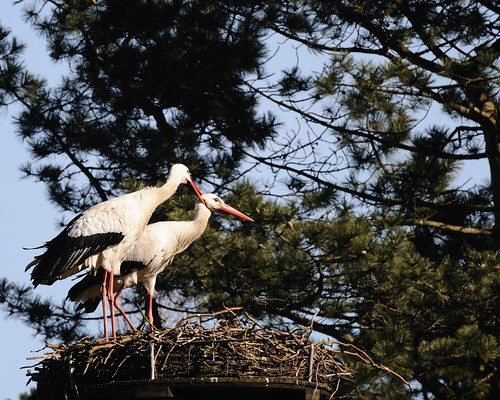all pics are clickable
After blogging about my first problems here I decided to give it another try with the new settings in my camera.
First of all, using the AF button proved to be an interesting experience. It takes a bit of getting used to, at first you're jabbing the AE-L button by mistake but after that there's certainly a speed advantage there.
My first chance I got when an egyptian goose decided to fly around. Came almost directly over me to give me this shot:

Not bad at all but not quite the level of sharpness I am aiming for. Let's look at settings:
| Exposure: | 0.001 sec (1/800) |
| Aperture: | f/13.0 |
| Focal Length: | 270 mm |
| Focal Length: | 269.1 mm |
| ISO Speed: | 640 |
Hmm... 1/800 and still movement? Why? According to a quick google the canadian goose can fly anywhere between 50 and 90 km/h. Let's assume this goose can do the same and let's assume it was doing 40 km/h. That's 11.1 meters/second which means still about 1.4 cm of movement in that 1/800. Of course part of it was compensated for by my panning movement but still... So shutter speed remains an issue there. Spot metering worked very well here.
Next I encountered a flock of great tits and blue tits in a pine grove. Even though these are about as common as muck they are still good practice. Working distance is a factor with these birds. If you can get as close as 5 meters it's already a lot and then it's still a tiny bird.

| Exposure: | 0.001 sec (1/1250) |
| Aperture: | f/5.6 |
| Focal Length: | 300 mm |
| Focal Length: | 302.0 mm |
| ISO Speed: | 640 |
The issue here is that my settings didn't do what I'd expect them to do. Despite auto iso I was shooting wide open here and the 70-300VR isn't at it's best wide open.
1/1250 is enough to freeze these birds if they are just sitting there. If they flutter from one branch to the next it doesn't do it.

OK, so shutter speed remains a focus.
Now, standing still about 5 meters from the trees did allow the birds to get used to me and ignore me which resulted in these two:

and

On this shot you can see a few ticks around the bird's eye.
Now, later in the day this setting came back to bite me in the behind.

Granted, it's a unique moment, pre-mating activities of Storks. And yes, I had about 30 seconds before she fled the nest. And 1530 is not a good time for black&white birds. But why is this pic unsharp?
| Exposure: | 0.003 sec (1/320) |
| Aperture: | f/20.0 |
| Focal Length: | 300 mm |
| Focal Length: | 302.0 mm |
| ISO Speed: | 640 |
There we go. At f20 most consumer zooms the diffraction spook rears it's ugly head. According to Thom Hogan the d300 itself shows diffraction from f11 onwards.
What happened is that my spot metering adjusted perfectly for the focus point on a white part of the stork And since I was at a relatively low shutterspeed the camera raised the aperture to prevent overexposure.
Next stork shot, a bit later.

A lot sharper and no wonder since I was at f9.
So... lessons learned?
- shutter speed is so important with birds
- watch your metering, you don't want to enter the diffraction zone
- Birds in flight depend at least as much on you and your reaction speed as they do on your gear
- A 70-300mm zoom is short but it's still possible to get some decent bird shots with it.
I'm already looking forward to my next experimental session.
1 comment:
Interesting. I tried to shoot a bird of prey from some distance using the 70-300 last weekend, and wasn't very successfull. Your writing suggests why that may be so.
And I hadn't heard about diffraction until now. Am now reading up on that at Luminous Landscape. ;-)
Roel
Post a Comment